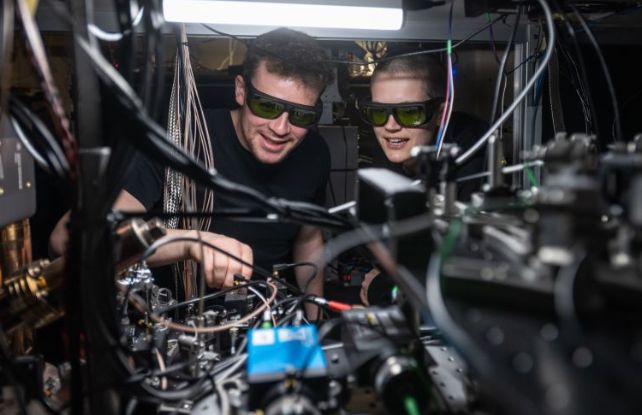
In a revolutionary application of teleportation, essential components of a quantum processor have been successfully distributed across multiple computers. This achievement demonstrates the potential for sharing quantum modules without sacrificing their efficiency.
Although the transfer was conducted within a space of just two meters (approximately six feet) in an Oxford University lab, this significant step showcases the viability of expanding quantum technology through the teleportation of quantum states over a network of interconnected systems.
Teleportation is a fascinating aspect of physics that can only be fully appreciated through the lens of quantum mechanics, where objects exist in a spectrum of potential states until measurement forces them into a defined condition.
By intertwining the uncertain states of separate entities through entanglement and methodically selecting measurements to execute on one of them, researchers can manipulate the entangled counterpart positioned some distance away to assume (and erase) the original object’s quantum identity.
While this form of teleportation may not enable instant travel for individuals through the cosmos, it effectively facilitates the transfer of essential information needed for logical operations within a quantum processor.
“Past experiments in quantum teleportation have primarily concentrated on exchanging quantum states between physically separate systems,” explains Dougal Main, lead author and physicist at Oxford University. “In our research, we harness quantum teleportation to establish interactions among these distant systems.”

Traditional computers utilize binary ‘on or off’ switches for processing strings of information, while quantum computers operate using complex distributions of possibilities known as qubits, often represented by features of neutral particles like charged atoms.
To operationalize this process, large numbers of particles must have their undecided states entangled in a controlled manner, avoiding interference from extraneous elements that could distort calculations.
Scaling existing technology to achieve this complexity presents challenges, necessitating error correction or shielding to maintain fragile quantum states long enough for measurement.
Connecting multiple smaller processors into a cohesive network could potentially create a quantum supercomputer. However, while quantum information can travel as light waves, the risk of irreversible data degradation makes this method unfeasible.
Teleportation relies on receiving measurements through traditional binary data. Once transmitted, operations on the receiving end can adjust their entangled particle to replicate the original’s state effectively.
In the Oxford University experiment, the quantum state that was teleported matched the original by 86 percent, sufficiently accurate to function as a logic gate for a straightforward operation known as a Grover’s algorithm, achieving a 71 percent success rate across the two quantum processors.
“By interlinking the modules with photonic connections, our system becomes more versatile, enabling upgrades or replacements of modules without disturbing the entire network,” Main states.
This flexibility in restructuring a quantum network could greatly expand the potential applications of this technology, transforming networks of computers into instruments capable of probing and testing the fundamental principles of physics.
The findings of this research were published in Nature.









